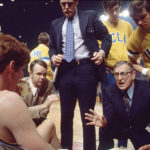Steve Palermo had it all.
Professionally, he was one of
the most respected umpires
in Major League Baseball.
Personally, he was a newlywed,
full of dreams.
In an instant, everything changed.
Just before 1 a.m. on July 7, 1991,
a few hours after umpiring a game
between the California Angels and
the Texas Rangers, Palermo and some
friends were at a Dallas restaurant
when they heard two waitresses were
being assaulted in the parking lot.
As the group rushed to help, a bullet
ripped into Palermo’s spine, leaving
him paralyzed.
“Here I was, supposedly at the top
of my career, at the top of my personal
life—I had been married for just five
months—and a doctor comes in to
tell me two days after I had been
shot that I am never going to walk
again,” Palermo tells SUCCESS. “I was
stunned. I said, ‘Wait a minute. I have
a career and I have to get back on the
fi eld. I have things to do.’ He shook
his head. It took my heart and soul
away when I heard that one.
“I felt sorry for myself for a little
while; then I asked myself, ‘What
are you going to do next?’ I let the
doctor and everyone know that, first
of all, not walking again was not an
acceptable prognosis.”
Even with that determination,
Palermo still needed inspiration
at times. He found it in two boys,
Mitchell and Cody, who pushed and prodded him in their own way
and reminded Palermo just how lucky he was.
"I
felt sorry for myself for a little while; then I asked myself, ‘What are you going to do next?’"
Mitchell, from New Orleans, suffered a head injury after a fall from
his bicycle. Doctors weren’t sure he’d survive the night. Cody, from
Texas, was riding a horse when he was thrown and dragged into a
fence post, causing a traumatic brain injury. Like Mitchell, Cody also
hadn’t been expected to survive. But both boys ended up at Dallas
Rehabilitation Institute, the same hospital as Palermo, and the threesome
became fast friends and competitors.
“I was on a treadmill putting one foot in front of the other and going
at an ever-so-slow pace,” Palermo says. “Cody got on the treadmill next
to me and he had them turn up the speed, and he was walking fine and
walking better. I told the therapist, ‘Turn my speed up a little please,’
and now it was a contest between me and Cody who was going to go
the fastest. He looks at me and says, ‘Steve, I’m going to beat you,’ and I
said, ‘Oh, no you’re not. Here I am, racing on a treadmill with a 6-year-old.
It was just amazing.”
Mitchell also faced verbal challenges since his brain injury left him
unable to speak. Palermo communicated with Mitchell by saying ‘At a
boy’ and giving him a thumbs-up. Palermo then took Mitchell’s thumb
and worked with him and showed him how to stick his thumb straight
up in the air.
“We would pass each other in the hallway—I was also in a wheelchair—
and we’d stop and give each other a thumbs-up like way to go
and then just keep on moving. Mitchell was incredible,” Palermo says.
At night, Mitchell and Cody met in Palermo’s room to watch baseball
on television. Palermo’s wife, Debbie, brought cookies and ice
cream from the nurses’ station and everyone watched the game until
the kids had to go to bed. “The kids would come to my room because
they knew that I worked with baseball, and my wife would get them
into bed with me, and one would be on one side of me and the other
would be on the other side of me,” Palermo says. “They’d ask me to tell
them stories about players and the game. It was the best therapy.”
After six weeks of treatment, Palermo began to regain the use of his
legs, and for the next seven years, he underwent physical therapy daily.
Today, Palermo walks with the use of a small leg brace and a cane
despite chronic pain and difficulty. But he walks… and he encourages
others through his motivational speeches around the country never to
admit defeat.
“My physical therapist would teach me how to wheel through a door
or get upstairs or get into a pool and I would do it differently,” Palermo
says. “She would say, ‘You know what, Steve? The end result is what I
want. You just do whatever it takes to do it. You figure it out on your
own. I think you’re going to do fine when you get into daily living and
with all of the obstacles in front of you. We consider them opportunities,
not obstacles. You just figure out how to do it.’ ”
Today, in addition to his
work with the Steve Palermo
Endowment for Spinal Cord
Research, Palermo serves as
a major league supervisor of
umpires, traveling to major
league games and reviewing
and grading his colleagues’
performances. These past two
years, he’s also worked for six
weeks with Triple-A umpires
in the Arizona Fall League.
Ranked No. 1 among
American League umpires
for overall performance by
The Sporting News the same
year he was shot, Palermo
still dreams of crouching
behind home plate or lining
up on base paths again in the
major leagues.
“One day I was on the
treadmill and walking, and
I asked my therapist, ‘Why
does my left foot splay a little
bit when I walk?’ ” he recalls.
“And she said, ‘Steve, first of
all, we can’t even understand
how you’re walking, so we
have no idea about your foot.
We can’t explain how you’re
putting one foot in front of
the other to start with. This
is something we’ve never seen
before.’ For me, this was part
of the process. This was another step in getting to where I want to get
to, which is walking, and running and getting back on the field and
doing what I was doing before.”
Palermo, now 60, credits his wife for helping him during his
recovery. He specifically remembers her reaction as he learned how to
cross a busy street in his wheelchair. Palermo’s mother-in-law couldn’t
watch, turning away and saying, “Here he survived a gunshot and he’s
going to get killed by a truck.” While Palermo made it across the street,
and also learned how to jump curbs and pop wheelies, his wife had
seen enough.
“Debbie said, ‘Wait a minute,’ and we all got together—me and my
wife and all of the therapists,” Palermo recalls. “My wife says, ‘Let’s
teach him how to walk, and if he can’t walk, he’ll be the best wheelchair
patient—I promise you. But let’s teach him how to walk fi rst, and
then we’ll teach him about the wheelchair.’ ”
The doctors may have underestimated Palermo, but his wife
understood his temperament and mentality. And those qualities drive
Palermo to this day—he continues to figure out how to live life to its
fullest and to inspire others.







